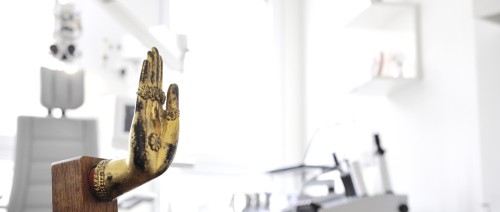
Diagnosis of Hearing Disorders Munich
Hearing assessments are of particular importance in ear, nose, and throat medicine. Audiology is a specialized discipline within the ENT profession. It focuses on the understanding of the physiology of hearing and the use of investigatory findings with diagnostics. To get an idea of the complexity of modern investigatory methods, it is helpful to visualize the process of hearing. Many switch points must be overcome just to create a hearing impression. Disturbances such as retarding, disrupting, or complete disabling of orderly flow of information can exist respectively in exactly as many levels as there are switch points.
Acoustic noise must first make it through an intact auditory canal to meet the correctly oscillating and closed eardrum. If there is a hole in the eardrum then the sound is largely absorbed. Then, it is transmitted through the tiny ossicular chain to the inner ear. The integrity and motility of the ossicles (hammer, anvil, and stirrup) must be maintained for this to function correctly. Today, diagnostics give us investigatory information on the extent, nature, and location of the causes of possible hearing impairment. These diagnostics include: tympanometry; reflex audiometry; tone and speech audiometry; and the suprathreshold procedure. Through such investigations, various ailments can be diagnosed such as accumulation of fluid in the middle ear, OME (otitis media with effusion, e.g. in children), ossicle joint stiffness, etc.
Acoustic noise travels as a sound wave via the movement of the footplate to the inner ear. On the one hand, the inner ear consists of the cochlea, in which the mechanical information of sound is encoded in the auditory nerve. On the other hand, it consists of the semicircular canals, which are responsible for balance. In diagnostic evaluation, hearing and balance are viewed as a functional system. The objective measurement methods include: videonystagmography (for testing inner ear and central motor functions); measurement of transient-evoked otoacoustic emission (TEOAE); and measurement of distortion-product otoacoustic emissions (DPOAE) (function of inner ear hair cells). The latter investigations are of particular importance in cases of acute inner ear impairment and tinnitus, as well as for infant and early childhood hearing tests.
The third level begins in the auditory nerve, which transports the information from the electromechanical acoustic coupling further to the auditory cortex. This is where the sensation of hearing first occurs. Alteration of the auditory nerve, inflammation, or tumors may express themselves by slowing down neuronal transmission. A type of EEG, aided by Brainstem Evoked Audiometry (BERA), can filter out a signal pattern specific to the auditory nerve. This respectively enables investigatory conclusions on auditory nerve dysfunction.
Determining the acoustic reflex threshold in children is a special issue. This is especially challenging with toddlers. Their cooperation is required in subjective audiometry. However, it can usually only be achieved indirectly, or with difficulty. All the same, acoustic reflex threshold approximation can be determined with objective methods such as BERA, TEOAEs, and DPOAEs. Diagnostic experience, patience, and state-of-the-art electrophysiological equipment are prerequisite for reliable investigations.

